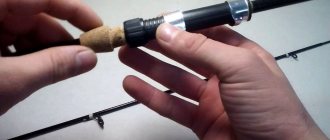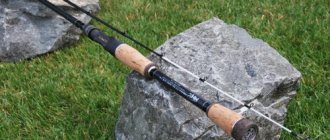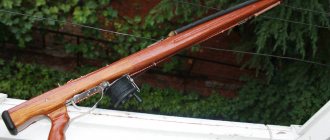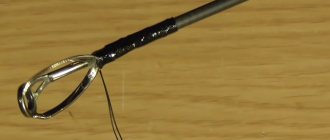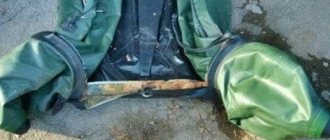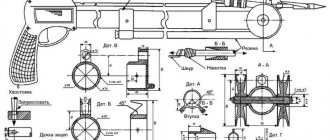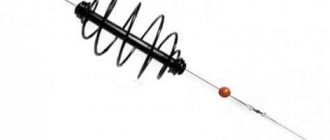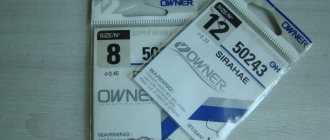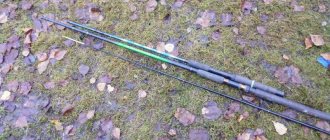How to repair a broken spinning rod?
Content
When a misfortune occurs in the form of a breakdown of a fishing device, the question immediately arises: “How to repair a spinning rod with your own hands?” There are several options for performing this process.
The user can:
- replace the knee by purchasing a new design;
- entrust repairs to professionals;
- try to repair the spinning rod yourself;
- buy a new product.
To carry out independent repairs of the spinning rod, you should replace the outer coupling and the inner insert. Tackle elements can be purchased at the store or used from old models lying in the closet. When looking for options for gluing a spinning rod together, we recommend choosing epoxy resin. In order for the work to go well and end in success, it is necessary to sand all the parts and glue them using the chosen product.
One of the most common sports equipment is spinning.
At the first stage of repairing spinning rods, you should carefully place the inner insert into the knee located below. It is very important to apply the adhesive correctly. Since the internal hole is too small, it is better to apply resin to the protruding part and gradually turn the part, recessing it deeper and deeper.
The coupling should be put on the broken part, after which the structure should be placed on the prepared insert. All joints and crevices must be generously lubricated with adhesive. The product dries within 24 hours.
What minor breakdowns can you repair yourself?
How to fix a spinning rod with your own hands? Naturally, not every problem can be fixed at home. In case of serious damage, the rod must be given to skilled rodbuilders who specialize in repairing “rods” and assembling new ones.
How to repair a broken spinning rod depends on the type of breakdown. Malfunctions that any angler can fix are:
- Breakage of the tip of a spinning rod - breaking of no more than 10–15 cm of the tip.
- Failure of rings and tulip - chips and scratches on the insert, fracture or deformation of the frame.
- The cork handle becomes unusable - over time, the cork gets wet, becomes rotten and begins to crumble.
Even a beginner who has experience working with the tool and knowledge of modern materials can restore a fishing rod after these troubles.
This is the biggest problem and the most difficult to fix and keep the rod working. How to repair a spinning rod? The tip must be fused back to the form. This is only possible in rods with a hollow tip. The repair is done as follows:
- It is necessary to select a rod that will be installed inside and can connect both parts of the top. It can be a sewing needle, a metal or carbon rod of suitable diameter.
- Both ends are cleaned of burrs and defects, then degreased with alcohol.
- Lubricate the inner insert with epoxy glue and install it in the form, connecting the two parts of the upper leg of the rod.
- Let the glue dry. For reliability, cover the joint with colorless varnish. You can apply a bandage made of strong threads to the former scrap.
It is worth noting that a repaired fishing rod can change its characteristics - action or test. Therefore, it is necessary to test the “stick” before a full trip to the shore of a river or lake.
How to repair a carbon spinning rod that has a solid tip? In this case, you will have to find and buy a new upper bend, since gluing the broken element to the form will not bring any result, and the tip will certainly break even from a small load.
https://www.youtube.com/watch?v=EcCYygoe6N8
Rod tulips or rings may require replacement due to failure. Most often, scratches and chips form on the inner insert, which lead to damage to the fishing line and cord. This reduces the strength of the equipment and can lead to breakage when throwing the bait forcefully or when landing a large fish.
How to repair a spinning rod by replacing the rings and tulip? This is done according to the following algorithm:
- We select and buy the necessary set of access rings and a tulip.
- We remove the old rings by heating their fastening with a candle or lighter.
- The seats must be cleaned with finishing sandpaper and degreased with alcohol.
- We install the ring and seat it with epoxy glue. We fix it on top by applying a bandage.
- After the glue has hardened, cover the place where the ring is placed with colorless varnish.
It is important not to disturb the alignment when installing new rings. This will lead to a decrease in casting distance due to increased friction of the line against the ring inserts. In addition, this can disrupt the structure of the spinning rod and will create critical overloads in the place where the ring is incorrectly fastened when landing fish.
How to repair a spinning rod yourself if the cork handle becomes unusable. When the material begins to crumble, you cannot hesitate. You should immediately begin to correct the breakdown so as not to aggravate the situation:
- Take a wine or champagne cork and finely rub it.
- Mix the resulting shavings with PVA glue.
- With the resulting thick mass we cover all defects and chips.
- After the glue has dried, sand the handle with fine sandpaper.
The handle repaired in this way looks almost like new and is able to last a long time.
Every real fisherman knows how much time and effort is spent on choosing and purchasing a suitable spinning rod. Therefore, it is not surprising that when an unexpected breakdown occurs, you lose your mood. In such situations, the ability to repair a spinning rod with your own hands helps out.
In order to successfully repair a spinning rod, you may need the following materials:
- Tube of suitable diameter. It will be inserted into a broken rod, so the tube should fit tightly, but not break the rod.
- Flat thread (nylon) or spinning cord.
- Epoxy two-component resin.
- Sandpaper.
- Scotch.
- Carbon fabric.
Now you can start repairing the spinning rod:
- The selected tube is ground, degreased with a solvent and lubricated with epoxy resin.
- One side of the tube is inserted into the broken rod. The broken part of the spinning rod is tightly placed on the other side of the tube. Both parts of the rod are connected, the tube is inside.
- The fracture site of the spinning rod is wrapped in carbon cloth soaked in epoxy resin and squeezed out.
- In order to remove excess resin, tape is tightly wrapped around the fabric.
- For greater strength, a flat nylon thread is wound onto the carbon fabric.
- Excess resin is removed with a cloth.
- The repair area is dried with a hairdryer to ensure the epoxy resin dries faster.
- The repaired fishing rod is placed near the battery for a day.
- The adhesive tape or nylon thread is unwound and cosmetic repairs are carried out.
If a light spinning rod is being repaired, then fabric is not used.
For this you need:
- sandpaper for cleaning;
- Super glue;
- thread.
Repairing the tip of the spinning rod itself is quite simple and will not take much time. The main thing in this matter is attentiveness. We begin to repair:
- It is better to take the tip of the rod without guides. If there are rings, they should be carefully removed.
- Both parts of the broken rod are cleaned so that the tip can be inserted into the rod (suitable in volume).
- The tip of the rod is inserted into the broken edge.
- The breakage area is tightly wrapped with thread.
- The thread is filled with glue.
- Drying.
The downside of this type of tip repair is that the rod becomes shorter. Tips can be repaired in the same way as rods. This method is described above.
Replacing the tulip
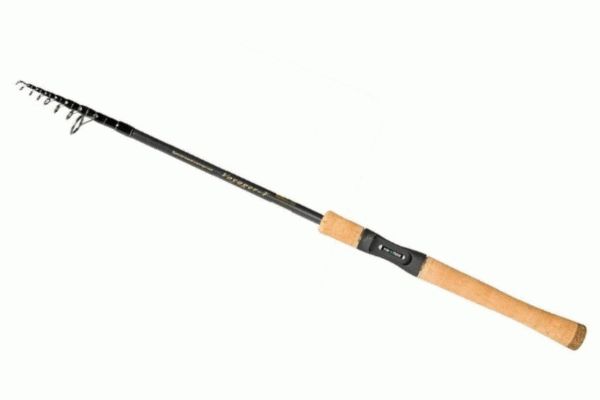
This is the easiest type of repair. It can even be carried out directly while fishing.
The first thing that is important is to release the tulip from the rod tip. The tulip is slightly heated and removed with a straightened paper clip.
Then the following manipulations are carried out:
- The tip is cleaned with sandpaper.
- Super glue is applied to the place where the tulip is attached (planted).
- The tulip is aligned with the remaining rings (strictly above them).
- Glue to the top of the spinning rod.
The simple repair of the tulip has been completed.
If a spinning rod breaks down, there is no need to rush and order the failed parts: knees, tip, reel seat. Some of the damage can be repaired yourself by repairing the spinning rod yourself.
Spinning rod repair
Repairing a fishing rod with your own hands is quite possible. The following elements are required as basic materials:
- a tube of the required diameter (this part should be approximately twice as long as the crack that has formed);
- Kevlar cord (it is possible to use a flat spinning cord);
- waterproof epoxy resin;
- in case of increased loads at the site of failure, you should stock up on glass or carbon fiber;
- scotch;
- film or other film.
Read more
How to catch catfish in the spring?
Repair of spinning rods begins with the preparation of materials. The tube must be sanded and lubricated with resin, after which it is ready to be installed in the elbow. The fishing device must be restored to the same condition as it was before the breakdown. The selected fabric material is cut out in the form of a rectangle and lubricated with adhesive, then it is wound around the crack site. The film strip along with the tape will help remove excess resin. To increase the strength of the structure, a purchased cord is wound around the fabric.
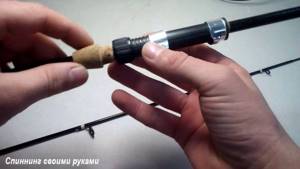
The repair of spinning rods begins with the preparation of materials.
After completing all the steps, it is recommended to place the tackle vertically and let the glue dry for 24 hours. Repairs to the spinning rod blank should be carried out in a timely manner. As soon as the smallest crack has formed, it urgently needs to be eliminated, otherwise the entire structure may break.
Spinning rod tip repair
The end of the rod is fragile and thin, so it is very easy to damage and break. Let's figure out how to repair the tip of a spinning rod.
There are several options to resolve the problem:
- Completely replace the tip of the tackle.
- Carry out the work manually with partial replacement.
The procedure will be successful only when the action plan is correctly developed. At the very beginning, you should find out the model of the device, the diameter of the tip and, ideally, get advice from a specialist.
If the tip of a spinning rod breaks, it is better to select a similar product without rings and pay attention to the correct selection of the action. The insertion must be clearly thought out. The fisherman is required to visually determine the length of the insert (this can be done by calculating which ring the crack is coming from). The attachment point must be cleaned and degreased, after which super glue is poured into the carbon part. Fiberglass fabric is coated with adhesive resin and inserted into the damaged area. To make the structure more durable, it is recommended to wrap the broken area with black thread and strengthen everything with glue. The product must dry thoroughly before use.
Many people cannot choose how to repair the tip of a spinning rod - with their own hands or go to a workshop. It's actually very easy to do the job yourself. In addition, for repairs you will need available materials that are found in every home.

The end of the rod is fragile and thin
When can a spinning rod break?
Every angler has experienced a breakdown of his fishing rod at least once in his life. This happened under different circumstances. Naturally, the question arises of how to repair a spinning rod with your own hands: the tip is broken, the tulip needs to be replaced, the handle has deteriorated, or the reel seat has stopped working. What to do?
Too serious damage to the fishing rod leads to a complete loss of its performance. It is almost impossible to restore it. However, more often the defect turns out to be minor and must be eliminated. As a result, you can continue fishing with a repaired spinning rod.
You can have your fishing rod repaired by craftsmen who specialize in repairing fishing gear. The work of such professionals costs money, but the result is a spinning rod that has not lost its original characteristics and remains just as durable and reliable.
Very minor breakdowns can be fixed on your own, especially those that do not require the use of specialized devices, materials and tools. Everyone at school had labor lessons, so everyone can cope with minor damage.
Immediately after purchase, the angler handles the rod very carefully, even overly carefully. As a result, the spinning rod does not “open up” completely and it seems as if the purchase does not meet expectations. This behavior is typical for beginners, for whom this fishing rod is their first or second serious acquisition.
Over time, the angler gets used to the spinning rod, begins to behave more boldly and in some situations loses his vigilance. Such negligence most often leads to rod breakage. While on the shore, on the way to a reservoir, or when storing at home, the following troubles may occur:
- You can accidentally step on your rod or a colleague’s rod. This happens if you carelessly put the spinning rod on the ground. Therefore, you should always place the fishing rod vertically, leaning it against a reliable support.
- When assembling or disassembling a fishing rod, some people forget and lean the spinning rod on the car door or on the open trunk. An accidental gust of wind or touching the door can easily slam it, breaking the fishing rod.
- When fishing from a watercraft, when casting, retrieving or retrieving, you can accidentally hit the blank against the side of the boat. More often than not, this does not immediately lead to failure, but a crack appears on the spinning rod, which reduces its strength and leads to failure at the next load, which is close to critical.
- Experienced lovers of sea fishing know well that carrying the fishing rod tip first is strictly not recommended. The slightest loss of concentration leads to the fact that he can stick into the ground or “rest” against the nearest tree or bushes. The spinning rod should always be carried with the handle forward.
- Each spinning rod has its own safety margin. One of the characteristics that shows its power is the lure test. Sometimes situations arise where you need to exceed the upper limit of the rod. However, not all fishing rods allow this. As a result, we have a breakdown, which, unfortunately, more often occurs in the handle area. Such a “stick” will no longer be repairable. Unless you can make yourself a “tool” for winter glitter from the upper knee.
- Inexperienced fishermen often break their spinning rods when fishing incorrectly. Moreover, the form can “form” not only from captured specimens. The most common mistake made by beginners is the desire to quickly pull the predator ashore, and he pulls it straight ahead or tries to throw it onto land with a fishing rod. Also, when trying to take the fish with your hand, the rod is pulled back excessively behind the head. As a result, an angle of less than 90 degrees is formed between the fishing line and the blank, which can lead to trouble if there is a sudden sudden jerk.
Defects that arise during the manufacturing process of the blank and assembling the rod occur much less frequently than due to the negligence of spinning players. If we compare breakdowns associated with manufacturing defects and improper handling by the fisherman, the score will be 1:9 in favor of the second factor.
To avoid spinning rod breakdowns, you must always be careful and focused. Basic rules for handling gear should be observed. Fishing rods should be transported for fishing folded in a hard case or in a tube.
Not all breakdowns can be fixed with your own hands. But still, some are “treated” quite successfully, and with some experience in such work, it is almost impossible to notice that the fishing rod has been repaired. The main defects that you can eliminate yourself are:
- rod tip breakage;
- replacing the tulip;
- replacing the ring;
- elimination of defects in cork handles.
Let's consider each case separately.
Of the defects listed above, this is the most complex. To repair the tip, you will need to select an internal rod of a suitable diameter. For example, for ultralight fishing rods, you can take a sewing needle.
- Both ends of the broken form are cleaned and degreased.
- The rod is lubricated with epoxy glue and inserted into the form.
- Let the glue dry.
- For reliability, the joint can be coated with colorless varnish or a bandage applied to it.
That's it, the repair of the spinning rod is completed, you can go to the pond.
Photo 1. Instead of the broken red tip, a new blue one was glued in.
Replacing the tulip
The need to replace the tulip may arise in the following situations:
- formation of chips and other defects on the insert;
- careless handling that led to a change in the shape of the tulip frame;
- breakage of a small section of the solid tip of the spinning rod.
In all cases, the fisherman needs to choose a suitable tulip. To do this, you should measure the diameter of the tip and select the desired product model from the catalog of manufacturers of spinning accessories.
- We remove the old tulip, having previously heated the place where it is attached with a lighter or candle.
Photo 2. The removed tulip and the cut off tip of the fishing rod.
- We clean the seat with fine sandpaper and degrease it with alcohol.
Photo 3. We clean the tip to the depth of the tulip.
- Then we apply epoxy glue to the tip.
- We put on the tulip, maintaining alignment with other access rings.
- We are waiting for the glue to harden.
That's it, the tulip has been replaced, the spinning rod looks like new.
Replacing the ring
The algorithm for replacing this element is similar to installing a new tulip:
- We purchase a new pass ring, choosing it according to the inner diameter of the insert.
- We remove the old one, heating the attachment point and removing the braid.
- We install a new ring, gluing it with epoxy glue and placing a bandage made of durable nylon thread on top.
- Let the glue dry. Cover the top area where the ring is installed with colorless varnish.
Photo 4. A ring wound with threads coated with black varnish.
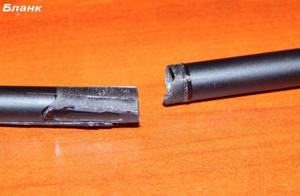
During the installation of a new guide ring, we make sure that the alignment is not disturbed. This is fraught with a decrease in casting range and the need to carry out repairs again.
Over time, chips and other defects appear on the cork handle. This causes some discomfort when fishing and does not look aesthetically pleasing. This nuisance can be easily restored. To do this, you will need glue and cork material, which can be used as a regular champagne or wine cap:
- Grate the cork.
- Mix the resulting shavings with PVA glue.
- We cover the existing defects with this mixture.
- Let the glue dry.
- Clean the handle with fine sandpaper.
The result is a refurbished handle that looks like new.
In order to repair a spinning rod with your own hands, you must first prepare the tools and materials:
- sharp painting knife;
- gas-burner;
- lighter;
- pliers;
- small file;
- sandpaper size 1000;
- cloth for metal;
- pieces of carbon fiber rods of various lengths and diameters for repairing a spinning rod knee that is damaged or broken;
- adhesives – waterproof PVA, epoxy, “Super glue” gel, for fixing bandages, guide rings, and repairing handles;
- waterproof clear varnish;
- nylon thread for fastening the installed access rings to the form, masking the place where the spinning rod broke;
- set of pass rings;
- corks from wine or champagne bottles.
Having prepared everything you need, you can repair both the failed last pass ring and the broken form near the butt.
Form repair
In modern two-piece plug spinning rods made of high-modulus graphite, the following types of breakdowns occur:
- cracks or breaks of the first (butt) leg of the spinning rod;
- cracking or breaking of the upper leg.
Repairing the form in both cases does not require significant expenses. It consists of the following steps:
- We inspect the rod at the point of breakage for longitudinal cracks. If they exist, the knee cannot be repaired - under load, the crack will inevitably increase in length and lead to complete failure of the entire knee.
- If no cracks are found, use a metal blade to trim the edges of the damaged knee.
- From old, but not split graphite knees from another broken fishing rod, we select and cut out a piece 10-15 cm long that fits tightly inside the parts of the broken knee - a scupper.
- If necessary, grind the piece a little with sandpaper and a fine file.
- We insert the scupper into one of the parts of the repaired knee, so that it fits tightly inside it by 7-8 cm. We generously lubricate the edge of the knee and the scupper inserted into it with epoxy glue. When repairing the butt knee, the scupper can be passed inside it by removing the plug located at the end of the handle after the spinning reel seat.
- We insert the second end of the spigot inside the other part of the broken knee so that the gap between the two joined parts of the broken knee is minimal.
- Cover the joint with epoxy glue.
- We wind a thin nylon thread over the connection, trying to match its color to the tone of the form coating.
- We cover the nylon thread bandage with waterproof varnish.
- If one of the rings of the spinning rod is very close to the place of breakage, then to strengthen the blank and disguise the bandage, remove it and fasten it above the junction of the broken parts of the knee with nylon thread.
- If the breakdown affected the varnish of the spinning rod rings or damaged the winding that attaches the ring to the blank, then it is easier to remove it and reinstall it.
As a result of such repairs, the rod retains its strength, flexibility, slightly changes the structure, but at the same time will allow you to avoid the purchase of an expensive exclusive knee. For the money spent, for any ordinary spinning player such repairs will cost a negligible amount
Spinning rod handle repair
To make a quality repair, you need to know how to disassemble a spinning rod. The procedure must be carried out as carefully as possible so as not to damage the structural parts.
Let's look at an example of how to disassemble the handle of a spinning rod. First, you need to remove the guide rings, then the front part of the handle must be dismantled. To perform this process, it is recommended to use a telescopic elbow, from which a tube 30 cm long is cut out. This element should be put on the form and, rotating clockwise, separate the plug from the form.
Read more
How to choose a spinning rod for perch fishing
Do-it-yourself spinning rod handle repair:
- You need to start by removing the damaged product and thoroughly cleaning the surface of the structure. Cork panel is used as the main material. It must be cut into pieces of 20 mm.
- The resulting strips should be soaked in water and boiled (the material should be in hot water for about 15 minutes).
- The basic process of repairing a cork spinning rod handle begins with winding the panel onto the desired surface and fastening it with strong threads. The material can be secured using moisture-resistant glue and the fixation can be improved using PVA electrical tape.
- The resulting product must dry; if the result does not satisfy the owner of the equipment, it is recommended to repeat the procedure. Quite often it is necessary to apply two layers.
At the same time, no one canceled the replacement of the spinning rod handle with a new one. The work can be entrusted to professionals.
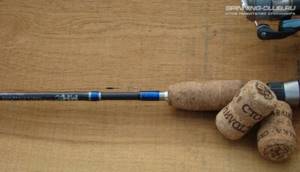
DIY spinning rod cork handle repair
Repair of access rings
Repairing rings on a spinning rod begins with removing the old winding of the part. The obligatory material is nylon thread. It can be selected according to the color of the gear. The process should begin by applying hot melt adhesive to the feet of the guide rings. Next, you should warm it up (you can use the flame of a lighter). Installation of the ring on a spinning rod should be carried out coaxially with respect to other rings.
At the final stage, it is necessary to secure the nylon thread and wrap the desired area not completely, leaving 5-10 mm free. At this point you should thread a loop of thread and seal the running end. After winding is completed, the nylon material is tucked into the loop made and pulled out. At the end of the repair, the result must be secured with varnish. Using this technology, anyone can repair a broken spinning rod.
Replacing rings on a spinning rod
Very often, a fisherman may be faced with the need to replace the ring on a spinning rod. This is a rather complex procedure that requires calm and accuracy. First you need to warm up that section of the rod that is designed for winding the ring elements. At the next stage, an incision is made in the area of the element's foot and the coating is completely removed. The edges of the handle should be sharpened, this will help you wind the cord easily.
Winding involves pulling the material and securing it securely. When the line reaches approximately four millimeters to the end, you need to place the cord and secure it by cutting off the end. Replacing the rings on a spinning rod with your own hands is completed by threading the thread through the loop and fixing the product.
Actions that lead to rod breakage
Before you start repairing a spinning rod with your own hands, you should stock up on a set of simple tools, which includes: a hacksaw blade, a stationery knife and small-sized pliers.
You should have a gas burner at hand; usually the smallest burner of a household gas stove and a lighter are used for these purposes. The list of materials that help to repair a spinning rod includes nylon thread with a diameter of 0.5 to 1.5 mm, carbon fiber that has served its age, old knees of used fishing rods (not necessarily spinning rods). Also in demand will be corks from bottles of dry or champagne wine and sets of passage rings of various diameters.
With the set of equipment and materials presented above, you can quickly and reliably make minor repairs to the tackle form. In the event of a serious breakdown, there are options for replacing the knee with a new one or transferring the gear into the hands of a master rodbuilder who specializes in restoring modern fishing equipment.
Tip creases are the most common defect in spinning tackle. Let's consider a special case when the tip of a spinning rod with a hollow structure breaks. The essence of the repair operation is to connect the broken part with the rest of the form. To implement the restoration of the crease, you will need to find a scupper with a suitable diameter.
A spigot is a 13–15 cm long cut from an old knee. In this case, the diameter of the selected insert must fit tightly into both hollow ends of the crease. Having selected a scupper that satisfies the conditions for a high-quality connection, a preparatory operation is carried out, the essence of which is to trim the edges of the crease. In the process of trimming the edges with a hacksaw blade, they are trimmed to even planes and sanded with sandpaper.
The prepared piece of carbon fiber blank is generously smeared with glue and inserted into the broken knee, tightening the joint as tightly as possible, to the minimum size of the gap resulting from the connection. We continue repairing the spinning rod by applying waterproof varnish to the joint and winding nylon thread over this layer.
The thread carefully placed at the joint remains to be soaked with the same varnish, and after waiting for the glue and coating to completely harden, which will happen no earlier than in one day, having sanded the irregularities and burrs, begin testing the gear. As a rule, this kind of work completely restores the functionality of the tackle, making its structure a little tougher.
Some spinning rod models have a monolithic quiver tip end. Breaks in such knees are not uncommon, but repairing a broken spinning rod will not be too difficult. If the tip breaks at a distance of 5–10 cm from the tulip, use the method of connecting the joint using a tube. As in the case of restoring a hollow form, a carbon fiber insert from the old elbow will be required.
We suggest you read: Catching perch with spinning in winter - Spinning - Fishing - Anglers
Having trimmed the ends of the crease, then, for better adhesion, the surface is sanded until it becomes visible velvety and degreased with a solvent. After the solvent has dried, glue is applied and the ends are inserted into the tube prepared in advance, pressing the ends tightly. After the glue has dried, the edges of the repair tube are cleaned with a file, covering the joint with waterproof varnish.
The repair method begins with heating the broken tip on which the tulip is placed. When heated, the glue will burn out and the connecting tube of the end ring will become free. The very tip of the quivertype is cleaned with sandpaper, bringing the diameter in accordance with the diameter of the connecting tube of the tulip. The connecting elements are degreased and glued together.
If this condition is not met, first apply a layer of nylon thread impregnated with epoxy glue to the tip and, after the winding has dried, install the ring. The tulip placed on the glue, or rather the joint, is covered with turns of the same nylon thread and covered with a layer of moisture-resistant varnish.
Handle repair
Let us please the spinning angler with the fact that restoring the handle is much easier than repairing the tip of the spinning rod. In fact, most spinning rod models are equipped with a cork handle that is comfortable in terms of tactile sensations. Cork is a rather soft and tiny material, and during the operation of the tackle, chipping, cracking and chipping occurs on the surface of the handle, which not only spoil the appearance of the tackle, but also cause inconvenience during fishing. Defects that arise can be repaired with cork crumbs, which are obtained by crushing a wine cork into fractions as small as possible.
Repair of spinning rods begins with treating chips and other defects in the handle by cleaning the surface from dirt and applying a layer of degreaser. The cork chips are poured into a small container and thoroughly mixed with waterproof glue until a thick plastic mass is obtained. The resulting composition is applied to the defective areas with a plastic spatula, firmly pressing the repair mixture into the structure of the handle.
Repair of the spinning rod knee is carried out in two cases: when the lower part of the plug is completely broken and when longitudinal cracks appear on the form. Fixing a broken blank is a more serious restoration operation, but the principle of execution is similar to the method of repairing the tip of a spinning rod with your own hands. To begin with, we determine the structure of the knee, which can be hollow or monolithic in design.
We suggest you read: Catching bream with a float rod in the fall in September and October
Before the first layer, the place where the inner tube is connected is coated with glue and the thread is tightly wound turn to turn to a length that overlaps the joint by at least 5 cm on each side of the defect. After drying, a second layer of thread is applied, again impregnating the reinforcing layer with an adhesive composition. With the outer coupling, these manipulations are performed at the boundaries of both joints.
After drying, repair of the whip is completed by varnishing the restored surface. Cracks are eliminated by performing a reinforcement operation. A thread soaked in glue is wound onto the defective surface, extending beyond the boundaries of the crack by at least 3 cm, after the lining has completely dried, subjecting the repair area to grinding and final varnishing.
Repair of a spinning rod may be due to a defect in the guide rings. In rings, a frequent breakdown is abrasion of the surface of the liners, which disables the cord, as well as deformation of the supporting leg or all legs with complete breaking off of the ring from the blank. To replace the insert, you will need to purchase a ring that is suitable for the diameter and type of insert.
Using heating with a lighter, the defective ring is carefully removed from the metal holder using the sharp tip of a knife. The clip is cleaned of the remnants of old glue, simply burning off the excess contents, and filled with fresh adhesive, after which a new liner is inserted. The remaining glue is removed, avoiding any roughness on the surface of the ring, and you continue to use the spinning rod comfortably.
By the way, exactly the same method is used to repair a tulip, with a deformed surface of the liner. A complete replacement of the ring begins with the removal of the old element of the form. To do this, open fire is used, heating and burning off the varnish and the reinforcing layer from the surface of the whip, pressing the legs of the ring to the blank.
Having removed the defective ring, the surface is completely cleaned of reinforcement residues, completing the process by grinding. After degreasing, the place where the passage ring is attached is coated with epoxy glue and the ring is installed. When installing a new passage ring, it is imperative to check the alignment of the element installation with the remaining rings.
The ring supports are attached to the blank using nylon thread impregnated with epoxy. The legs are tightly pulled to the form with a thread, tightly applying even turns. After the glue has hardened, the fastening points are treated with fine abrasive sandpaper and covered with waterproof varnish.
We suggest you read: Choosing a light spinning rod
To avoid repairs to spinning rods, let us draw the angler’s attention to a number of the most common situations that lead to equipment breakdown. The fishing process itself does not always render the gear unusable. This is largely due to carelessness during transportation and storage of spinning rods. So, quite often, an angler breaks the knees of a spinning rod right in the car when storing things and inattention when closing the doors, when the tackle gets into the clamping area of the side door or trunk.
